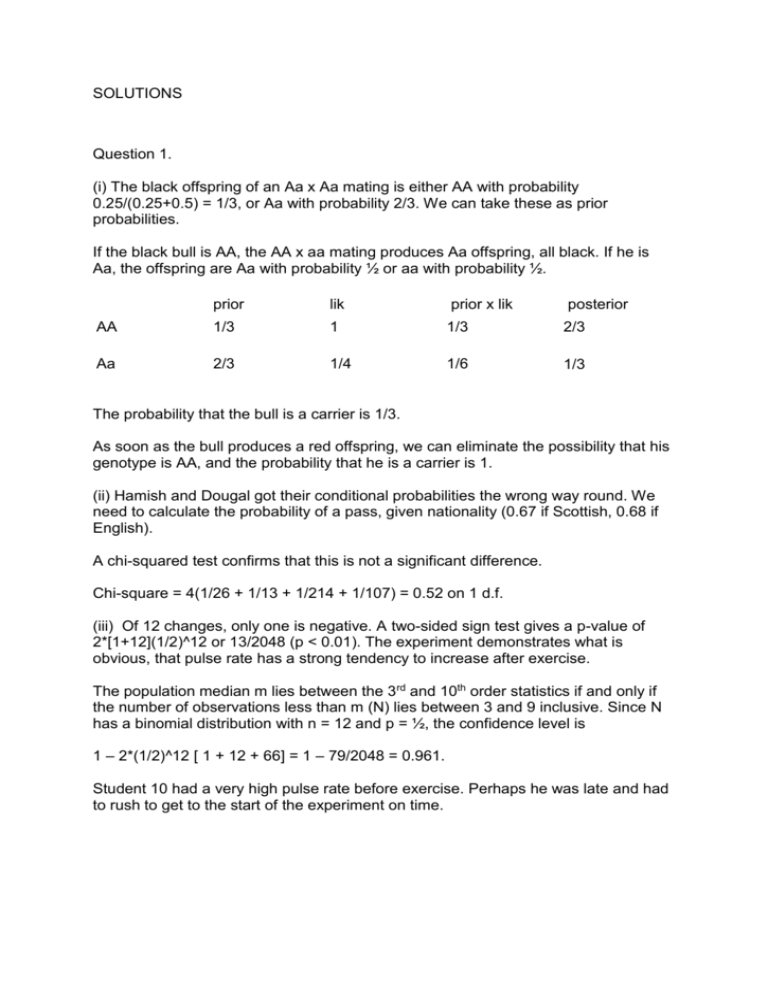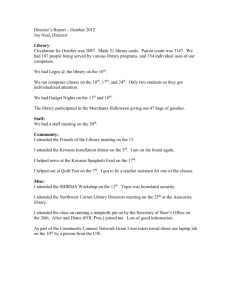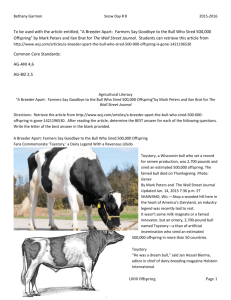SOLUTIONS Question 1. (i) The black offspring of an Aa x Aa mating
advertisement

SOLUTIONS Question 1. (i) The black offspring of an Aa x Aa mating is either AA with probability 0.25/(0.25+0.5) = 1/3, or Aa with probability 2/3. We can take these as prior probabilities. If the black bull is AA, the AA x aa mating produces Aa offspring, all black. If he is Aa, the offspring are Aa with probability ½ or aa with probability ½. prior lik prior x lik posterior AA 1/3 1 1/3 2/3 Aa 2/3 1/4 1/6 1/3 The probability that the bull is a carrier is 1/3. As soon as the bull produces a red offspring, we can eliminate the possibility that his genotype is AA, and the probability that he is a carrier is 1. (ii) Hamish and Dougal got their conditional probabilities the wrong way round. We need to calculate the probability of a pass, given nationality (0.67 if Scottish, 0.68 if English). A chi-squared test confirms that this is not a significant difference. Chi-square = 4(1/26 + 1/13 + 1/214 + 1/107) = 0.52 on 1 d.f. (iii) Of 12 changes, only one is negative. A two-sided sign test gives a p-value of 2*[1+12](1/2)^12 or 13/2048 (p < 0.01). The experiment demonstrates what is obvious, that pulse rate has a strong tendency to increase after exercise. The population median m lies between the 3rd and 10th order statistics if and only if the number of observations less than m (N) lies between 3 and 9 inclusive. Since N has a binomial distribution with n = 12 and p = ½, the confidence level is 1 – 2*(1/2)^12 [ 1 + 12 + 66] = 1 – 79/2048 = 0.961. Student 10 had a very high pulse rate before exercise. Perhaps he was late and had to rush to get to the start of the experiment on time. Question 2. (i) In standardized units, we require the probability of a value between –1 and +1 and the probability of a value less than –1.5. From tables of the normal distribution, the first of these is 2*(0.8413 – 0.5) = 0.6826 and the second is 1 – 0.9332 = 0.0668. (ii) The quartiles divide the distribution into 4 equal parts by probability. The second quartile (median) divides it into two equal parts. From normal tables, we find that q = 0.6745. The magnitude of Z is greater than q if either Z > q or Z < –q and the probability that the magnitude of Z is greater than q is pr(Z > q) + pr(Z < q) = ¼ + ¼ = ½. (iii) T, the time to the first event in a Poisson process has an exponential distribution, which is such that pr(T > t) = exp( – r t), where r is the rate of the process (events per unit time). If r = 12 events per minute, and t = 10/60 minutes, the required probability is exp( –2) or 0.13. Question 3 Part i Analysis of Variance Table Source Regression Residual Error Total DF 2 27 29 SS 362.6 596.10 958.70 MS 181.30 22.08 F 8.21 P 0.002 H0: group1=group2=group3 HA: not all equal The assumptions are that the data are independent, normally distributed and the group variances are the same F=8.21 F2,27; α=0.05=3.353 As the calculated F is greater than the critical value of 3.353 then we can reject the H0 of no difference between groups and conclude that there is at least one group mean that is different. Is there evidence that students who attended both revision sessions do better than those who attended none? Group 3 attended 2 revision sessions. Mean grade = 80.0% Group 1 attended no revision sessions. Mean grade = 71.5 1 1 𝑡 = (𝑥3 − 𝑥1 )/𝑠𝑝(√𝑛3 + 𝑛1) where sp=√𝑀𝑆𝐸 = √22.08 = 4.698936 t = 4.044868 t0.025,27 = 2.052 The calculated t is 4.70 which is greater than the critical value of 2.052 so there is evidence that the group 3 which attended 2 revision sessions did better than the group 1 that attended no sessions. Question 3 Part ii The slope=9.790. This means that we would predict the waiting time to increase by 9.790 min for every additional 1 min increase in duration. The t statistic = 9.970/1.30=7.669231 t0.025,19 = 2.093 7.67 is > 2.093 therefore there is evidence that there a significant relationship between waiting time and duration. The coefficient of determination or r2 = 74.9% (r2 = sum of squares regression / total sum of squares = 2130.6/2844.3=0.749). This means that 74.9% of the variation in waiting time is explained by duration. 95% prediction interval if duration is 3 min: If the duration of the last eruption was 3 min our equation would estimate that the next eruption would occur in 60.8min with 95% prediction interval of 47.24min – 73.53 min. If a tourist can only wait 1 hour then this interval may be too wide







